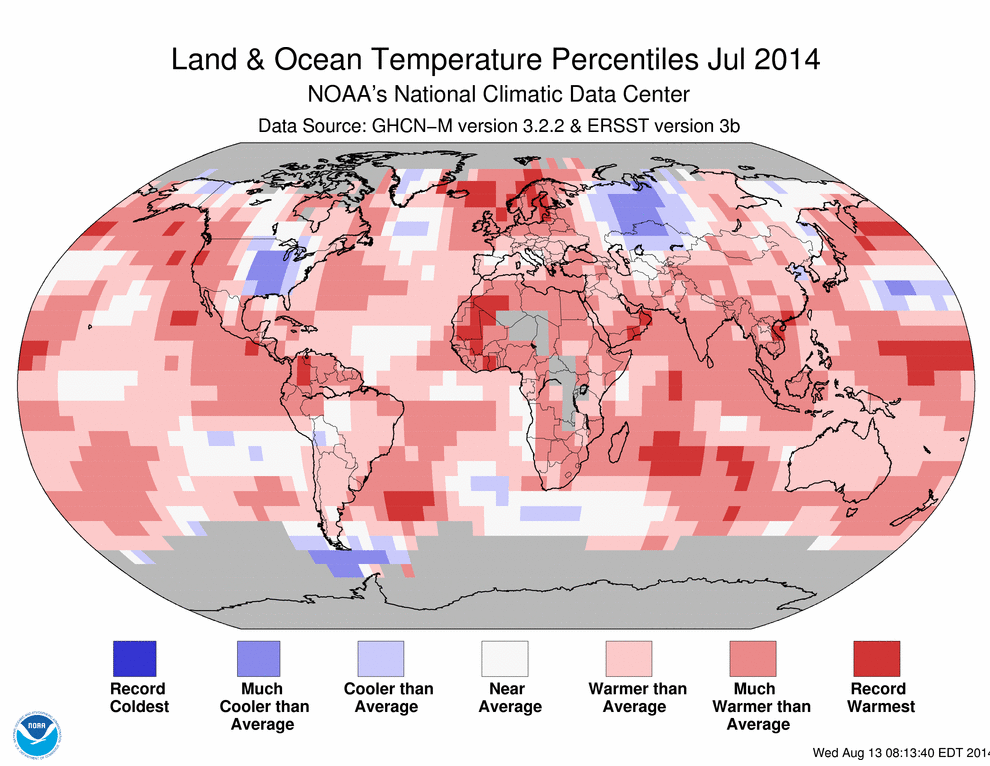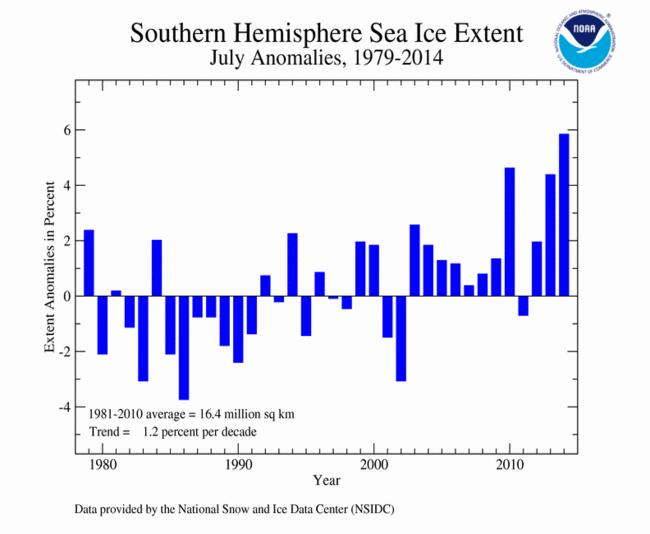Monthly Report Summary Information
The Monthly Report Summary Information is a synopsis of the collection of national and global summaries released each month.
Global Summary Information - July 2014
See Full Report
Global temperature fourth highest on record for July;
Global oceans remain record warm.
The globally averaged temperature over land and ocean surfaces for July 2014 was the fourth highest for July since record keeping began in 1880. It also marked the 38th consecutive July and 353rd consecutive month with a global temperature above the 20th century average. The last below-average global temperature for July was in 1976 and the last below-average global temperature for any month was in February 1985.
Global temperature highlights: July
- The combined average temperature over global land and ocean surfaces for July 2014 was the fourth highest for the month at 61.55°F (16.44°C), or 1.15°F (0.64°C) above the 20th century average of 60.4°F (15.8°C). The margin of error associated with this temperature is ±0.23°F (0.13°C).
- The July global land temperature was the 10th highest for July on record at 1.33°F (0.74°C) above the 20th century average of 57.8°F (14.3°C). The margin of error is ±0.32°F (0.18°C). Record warmth was notable in parts of northern Europe and a swath of northwestern Africa.
- Thirty-two countries or territories across every continent, with the exception of Antarctica, reported at least one station with a record warm July temperature. The U.S. and the Russian Federation each had stations with both record warm and record cold July temperatures. The period of record varies by station. Some national temperature highlights include:
- July 2014 was the warmest month of any month for Norway, with a temperature 7.7°F (4.3°C) higher than the 1961-1990 average, surpassing the previous record warmest month by 1.8°F (1.0°C). National records date back to 1900.
- Denmark was near record warm, as July 2014 tied with 1994 as the second warmest July, behind only 2006, since national records began in 1874. The country as a whole set a new record for number of summer days (temperature surpassing 77°F / 25°C), at 15.5 days, compared with an average of 2.6 days.
- The July temperature for the United Kingdom was 2.2°F (1.2°C) higher than the 1961-1990 average, tying with 1933 as the eighth warmest July on record. Every month during 2014 to date has been warmer than average.
- In the U.S., several states in the West had a July temperature among their 10 warmest, while in the Midwest, Indiana and Arkansas each had their coolest July in the 120-year period of record. The Arkansas average temperature was 4.6°F (2.6°F) below the 20th century average, beating the previous record cold July that occurred in 1967.
- For the ocean, the July global sea surface temperature was 1.06°F (0.59°C) above the 20th century average of 61.5°F (16.4°C), tying with 2009 as the highest for July on record. The margin of error is ±0.11°F (0.06°C).
- Neither El Niño or La Niña conditions were present across the central and eastern equatorial Pacific Ocean during July 2014. Temperature departures from average in this region, a major indicator of the conditions, cooled slightly compared with the previous month. NOAA's Climate Prediction Center estimates that there is about a 65 percent chance that El Niño conditions will develop during the Northern Hemisphere fall and winter.
Polar ice highlights: July
- The average Arctic sea ice extent for July was 3.19 million square miles, 560,000 square miles (15.0 percent) below the 1981-2010 average and the fourth smallest July extent since records began in 1979, according to the National Snow and Ice Data Center. The seasonal sea ice extent decline during July was near average, with rapid ice loss the first half of the month and slower ice loss during the second half.
- On the opposite pole, the Antarctic sea ice extent for July was 6.72 million square miles, 370,000 square miles (5.8 percent) above the 1981-2010 average. This marked the largest July Antarctic sea ice extent since records began in 1979, surpassing the previous record large July Antarctic sea ice extent that occurred in 2010 by about 80,000 square miles. Eight of the past 12 months have had a record large Antarctic sea ice extent.
Precipitation highlights: July
- Extreme wetness was observed during July over several regions, including parts of southeastern Europe. Extreme dryness was scattered across different parts of the globe, including part of the central U.S. and various regions in South America, Africa, and Europe.
- France had its wettest July since its national records began in 1959, receiving double the 1981-2010 average and surpassing the previous record set in 2000. It was also record wet across the adjacent western half of Switzerland.
- The Southwest Monsoon began in early June over India. For the period June 1 to July 30, rainfall for the country as a whole was 91 percent of the 1951-2000 average. Central India received 117 percent of its average rainfall, while the East and Northeast region received just 59 percent of average. The Southwest Monsoon season typically ends in late September.
Global temperature highlights: Year-to-date
- The first seven months of 2014 (January–July) tied with 2002 as the third warmest such period on record, with a combined global land and ocean average surface temperature 1.19°F (0.66°C) above the 20th century average of 56.9°F (13.8°C). Only 2010 and 1998 were warmer. Record warmth for the period was observed in northern and western Europe, parts of western North America, and regions in Far East Russia, southeastern Australia, and the eastern Black Sea region. Record cold was observed in the Lake Superior region of North America. The margin of error is ±0.20°F (0.11°C).
- The January–July worldwide land surface temperature was 1.80°F (1.00°C) above the 20th century average, the sixth warmest such period on record. The margin of error is ±0.41°F (0.23°C).
- The global ocean surface temperature for the year to date was 0.54°F (0.97°C) above average, the third warmest such period on record behind 1998 and 2010. Both 1998 and 2010 began with El Niño conditions present in the equatorial Pacific Ocean. The margin of error is ±0.09°F (0.05°C).
 NOAA's National Centers for Environmental Information
NOAA's National Centers for Environmental Information



